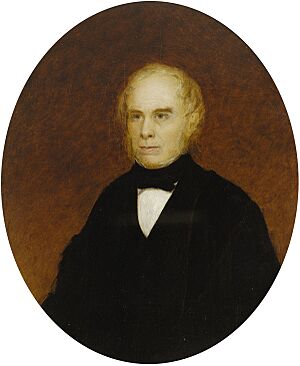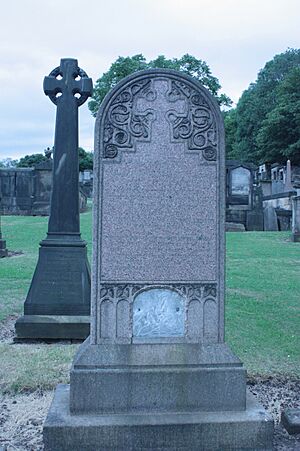William MacGillivray facts for kids
Quick facts for kids
William MacGillivray
|
|
|---|---|

William MacGillivray in middle age,
probably in 1841 Collection of the University of Aberdeen |
|
| Born | 25 January 1796 |
| Died | 4 September 1852 (aged 56) Aberdeen
|
| Resting place | Edinburgh |
| Nationality | Scottish |
| Scientific career | |
| Fields | Ornithology |
| Institutions | University of Aberdeen |
William MacGillivray (born January 25, 1796 – died September 4, 1852) was a famous Scottish naturalist and ornithologist. This means he was a scientist who studied nature, especially birds! He helped us understand a lot about the animal world.
Contents
Life of a Naturalist
William MacGillivray was born in a place called Old Aberdeen in Scotland. He grew up on the beautiful island of Harris.
Later, he went back to Aberdeen to study Medicine at King's College. He finished his studies in 1815.
After college, he worked as an assistant in anatomy classes. In 1823, he became an assistant to Robert Jameson. Jameson was a professor of Natural History at the University of Edinburgh.
From 1831, MacGillivray was in charge of the museum at the Royal College of Surgeons of Edinburgh. He left this job in 1841. Then, he became a professor of Natural History at Marischal College in Aberdeen.
Friendship with Audubon
MacGillivray was good friends with John James Audubon. Audubon was a very famous American bird expert. MacGillivray helped Audubon write a big part of his book, Ornithological Biographies. This book was all about birds!
Audubon even named a bird after his friend. It's called MacGillivray's warbler.
William MacGillivray passed away in Aberdeen in 1852. He is buried in New Calton Cemetery in Edinburgh.
MacGillivray's Family
In 1820, William MacGillivray married Marion Askill. She was from Harris, just like him. They had ten children together, but sadly, two of them died when they were very young.
Two of MacGillivray's sons also became naturalists, following in their father's footsteps.
- His oldest son, John MacGillivray (1822–1867), wrote about his journey around the world. He was the naturalist on a ship called HMS Rattlesnake.
- Another son, Paul, wrote a book about plants in Aberdeen in 1853. He also gave 214 of his father's amazing paintings to the Natural History Museum.
His Lasting Impact
William MacGillivray made an important discovery about crows. He correctly saw the difference between the hooded crow and the carrion crow. For a long time, people thought they were just different types of the same bird.
But in 2002, scientists used DNA evidence to prove MacGillivray was right! The hooded crow was then officially recognized as its own separate species.
Books and Publications
William MacGillivray wrote many books about nature and animals. Here are some of his works:
- Lives of Eminent Zoologists from Aristotle to Linnaeus (1830)
- A Systematic Arrangement of British Plants (1830)
- The Travels and Researches of Alexander von Humboldt. (1832)
- A History of British Quadrupeds (1838)
- A Manual of Botany, Comprising Vegetable Anatomy and Physiology (1840)
- A History of the Molluscous Animals of Aberdeen, Banff and Kincardine (1843)
- A Manual of British Ornithology (1840–1842)
- A History of British Birds, indigenous and migratory, in five volumes (1837–1852)
- Natural History of Deeside and Braemar (1855) – published after he died
- A Hebridean Naturalist's Journal 1817-1818 (1996) – published after he died
- A Walk to London (1998) – published after he died
He also drew pictures for other books, like Henry Witham's 1833 book about fossil plants. And he helped edit a book called The Conchologist's Text-Book, which was about shells.
See also
- Thomas Bewick
- William Yarrell



